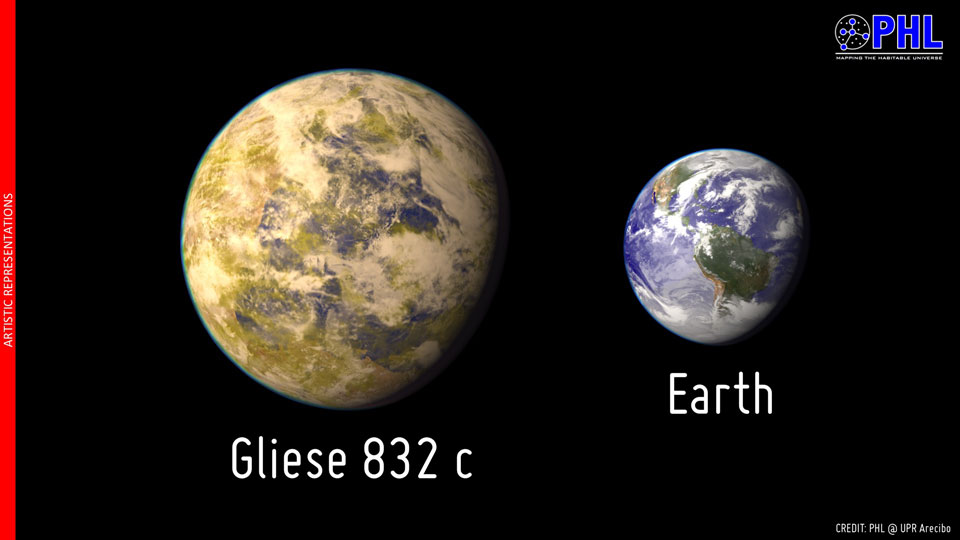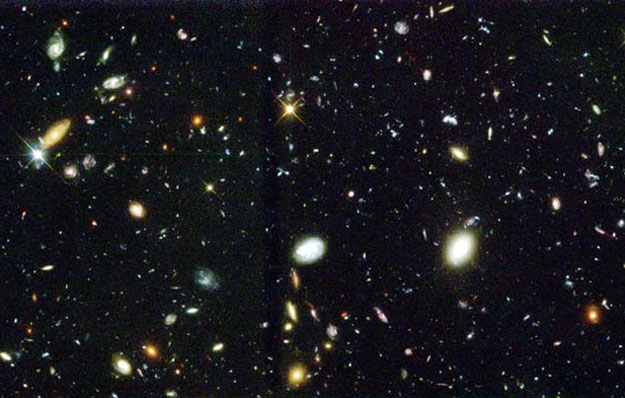| << Previous | Index | Next >> |
2015 An image snapped on July 7 by the New Horizons spacecraft while just under 5 million miles (8 million kilometers) from Pluto is combined with color data in this most detailed view yet of the Solar System's most famous world about to be explored. The region imaged includes the tip of an elongated dark area along Pluto's equator already dubbed "the whale". A bright heart-shaped region on the right is about 1,200 miles (2,000) kilometers across, possibly covered with a frost of frozen methane, nitrogen, and/or carbon monoxide. The view is centered near the area that will be seen during New Horizons much anticipated July 14 closest approach to a distance of about 7,750 miles (12,500 kilometers).
2014
2013 Supergiant star Gamma Cygni lies at the center of the Northern Cross, a famous asterism in the constellation of the Swan (Cygnus). Known by the proper name Sadr, the bright star also lies at the center of this gorgeous skyscape, featuring a complex of stars, dust clouds, and glowing nebulae along the plane of our Milky Way galaxy. The field of view spans over 3 degrees (six Full Moons) on the sky and includes emission nebula IC 1318 and open star cluster NGC 6910. Left of Gamma Cygni and shaped like two glowing cosmic wings divided by a long dark dust lane, IC 1318's popular name is understandably the Butterfly Nebula. Above and slightly left of Gamma Cygni, are the young, still tightly grouped stars of NGC 6910. Some distance estimates for Gamma Cygni place it at around 1800 light-years while estimates for IC 1318 and NGC 6910 range from 2,000 to 5,000 light-years.
2012 What did you do over your winter vacation? If you were the Opportunity rover on Mars, you spent four months of it stationary and perched on the northern slope of Greeley Haven -- and tilted so that your solar panels could absorb as much sunlight as possible. During its winter stopover, the usually rolling robot undertook several science activities including snapping over 800 images of its surroundings, many of which have been combined into this 360-degree digitally-compressed panorama and shown in exaggerated colors to highlight different surface features. Past tracks of Opportunity can be seen toward the left, while Opportunity's dust covered solar panels cross the image bottom. Just below the horizon and right of center, an interior wall of 20-kilometer Endeavour Crater can be seen. Now that the northern Martian winter is over, Opportunity is rolling again, this time straight ahead (north). The rover is set to investigate unusual light-colored soil patches as it begins again to further explore the inside of Endeavour, a crater that may hold some of the oldest features yet visited.
2011 Space shuttle orbiter Atlantis left planet Earth on Friday, July 8, embarking on the STS-135 mission to the International Space Station. The momentous launch was the final one in NASA's 30 year space shuttle program that began with the launch of the first reusable spacecraft on April 12, 1981. In this reflective prelaunch image from July 7, Atlantis stands in a familiar spot on the Kennedy Space Center's pad 39A, after an early evening roll back of the pad's Rotating Service Structure. The historic orbital voyages of Atlantis have included a Hubble Space Telescope servicing mission, deployment of Magellan, Galileo, and the Compton Gamma-ray Observatory, and seven trips to the Russian space station Mir. Scheduled to dock once again with the International Space Station on Sunday, Atlantis has now made its 33rd and final trip to orbit.
2010 Seen from our edge-on perspective, the Milky Way Galaxy sprawls across the middle of this false-color, all sky view. The expansive microwave map is based on 1 year's worth of data from instruments onboard the sky-surveying Planck spacecraft. Remarkably, the bright stripe of gas and dust clouds along the galactic plane and the galaxy's enormous arcing structures seen at microwave energies are hundreds or thousands of light-years away, while the mottled regions at the top and bottom represent the Cosmic Microwave Background (CMB) radiation, some 13.7 billion light-years distant. Left over from the Big Bang, fluctuations in the CMB reflect the origins of structure in the evolving universe. Analyzing the microwave data, Planck scientists plan to separate the contributions of the Milky Way and CMB radiation. The work will ferret out the characteristics of the CMB across the entire sky and glean information about the make up of our Milky Way Galaxy.
2009 Born in supernovae, pulsars are spinning neutron stars, collapsed stellar cores left from the death explosions of massive stars. Traditionally identified and studied by observing their regular radio pulsations, two dozen pulsars have now been detected at extreme gamma-ray energies by the Fermi Gamma-ray Space Telescope. The detections include 16 pulsars identified by their pulsed gamma-ray emission alone. This gamma-ray all-sky map, aligned with the plane of our Milky Way Galaxy, shows the pulsar positions, with the 16 new Fermi pulsars circled in yellow (8 previously known radio pulsars are in magenta). Bizarre stellar corpses, the Vela, Crab, and Geminga pulsars on the right are the brightest ones in the gamma-ray sky. Pulsars Taz, Eel, and Rabbit are named for the nebulae they are now known to power. The Gamma Cygni and CTA 1 pulsars at the left also reside within expanding supernova remnants of the same name.
2008 On July 5th, wandering planets, bright stars, and a young crescent Moon graced western skies after sunset. Arrayed along the solar system's ecliptic plane, the three celestial beacons forming this skyscape's eye-catching line-up with the Moon are Saturn (upper left), then Mars, and finally Regulus, alpha star of the constellation Leo. Of course planet Earth itself lies in the foreground, a scene dominated by the city lights of Santa Barbara, California. The smoky haze hanging over the city is from threatening wild fires still burning along the hill at the right. On Thursday evening, Saturn and Mars can be seen in a much closer pairing or conjunction, separated by only about 3/4 degree on the sky.
2007 When is the Sun most distant from Earth? It happened again just this past weekend. A common misconception is that the Sun is most distant during the winter, when it's the coldest. In truth, however, the seasonal temperatures are more greatly influenced by the number of daylight hours and how high the Sun rises. For example, during northern winter, the tilt of the Earth causes the Sun to be above the horizon for a shorter time and remain lower in the sky than in northern summer. The picture compares the relative size of the Sun during Earth's closest approach in January (northern winter) on the left, and in July (northern summer) on the right. The angular size of the Sun is noticeably smaller during July, when it is farther away. If the Earth's orbit was perfectly circular, the Sun would always appear to be the same size. These two solar images were taken from Spain during 2006, but the same effect can be seen in any year from any Earth-bound location.
2006 In 1787, astronomer William Herschel discovered the Eskimo Nebula. From the ground, NGC 2392 resembles a person's head surrounded by a parka hood. In 2000, the Hubble Space Telescope imaged the Eskimo Nebula. From space, the nebula displays gas clouds so complex they are not fully understood. The Eskimo Nebula is clearly a planetary nebula, and the gas seen above composed the outer layers of a Sun-like star only 10,000 years ago. The inner filaments visible above are being ejected by strong wind of particles from the central star. The outer disk contains unusual light-year long orange filaments.
2005 The many spectacular colors of the Rho Ophiuchi (oh'-fee-yu-kee) clouds highlight the many processes that occur there. The blue regions shine primarily by reflected light. Blue light from the star Rho Ophiuchi and nearby stars reflects more efficiently off this portion of the nebula than red light. The Earth's daytime sky appears blue for the same reason. The red and yellow regions shine primarily because of emission from the nebula's atomic and molecular gas. Light from nearby blue stars - more energetic than the bright star Antares - knocks electrons away from the gas, which then shines when the electrons recombine with the gas. The dark regions are caused by dust grains - born in young stellar atmospheres - which effectively block light emitted behind them. The Rho Ophiuchi star clouds, well in front of the globular cluster M4 visible above on far lower left, are even more colorful than humans can see - the clouds emits light in every wavelength band from the radio to the gamma-ray.
2004 Have you heard a lot about ringed planets lately? Well, consider this gorgeous celestial vista centered on the Milky Way's own planetary nebula M57, the famous Ring Nebula. The wide view is a composite of three exposures; one to record the details of the inner roughly one light-year span of the familiar nebula, one to record the surprisingly intricate but faint outer rings of glowing hydrogen gas, and one to pick up the rich assortment of distant background galaxies. By chance, one of the background galaxies, IC 1296 at the upper left, is close enough to show its barred, spiral structure making an attractive visual comparison with M57. Interestingly, though IC 1296 is 200 million light-years away compared to only 2 thousand light-years for M57, a faint ring is also apparent around the outer reaches of the distant spiral galaxy.
2003 Astronomers have discovered a planetary system more similar to our own Solar System than any known previously. The bright star HD70642, visible with binoculars toward the constellation of Puppis, was already known to be a star like our Sun. Now a planet with twice Jupiter's mass has been discovered in a nearly circular orbit at approximately half the orbital distance of Jupiter. Such an orbit allows the possibility of habitable Earth-type planets orbiting further in, a possibility not likely with all previously discovered planetary systems with massive planets occupying disruptive closer elliptical orbits. The above illustration indicates what the HD70642 planetary system might look like from a hypothetical moon orbiting the newly discovered planet. At only 90 light years distant, extremely faint early radio broadcasts from Earth are now passing this planetary system.
2002 If you took a picture of the Sun at the same time each day, would it remain in the same position? The answer is no, and the shape traced out by the Sun over the course of a year is called an analemma. The Sun's apparent shift is caused by the Earth's motion around the Sun when combined with the tilt of the Earth's rotation axis. The Sun will appear at its highest point of the analemma during summer and at its lowest during winter. Analemmas created from different Earth latitudes would appear at least slightly different, as well as analemmas created at a different time each day. The analemma pictured to the left was built up by Sun photographs taken from 1998 August through 1999 August from Ukraine. The foreground picture from the same location was taken during the early evening in 1999 July.
2001 Where on Earth is the air most polluted? Recently released images from the Terra satellite show not only areas of high pollution, but also how polluted air moves. In the above image, locations of higher air pollution are shown in red. The pollutant tracked is carbon monoxide (CO) at a height of about 5 kilometers. Clearly, Earth's Northern Hemisphere shows much more CO than the south. The new data indicate, however, that pollution moves on a global scale. About half of all CO emission is of human origin, and much of this is created in large fires.
2000 Galaxies like colorful pieces of candy fill the Hubble Deep Field - one of humanity's most distant optical views of the Universe. The dimmest, some as faint as 30th magnitude (about four billion times fainter than stars visible to the unaided eye), are very distant galaxies and represent what the Universe looked like in the extreme past, perhaps less than one billion years after the Big Bang. To make the Deep Field image, astronomers selected an uncluttered area of the sky in the constellation Ursa Major (the Big Bear) and pointed the Hubble Space Telescope at a single spot for 10 days accumulating and combining many separate exposures. With each additional exposure, fainter objects were revealed. The final result can be used to explore the mysteries of galaxy evolution and the infant Universe.
1999 At 1.6 billion years old, this cluster of stars is beginning to show its age. NGC 7789 is an open or galactic star cluster about 8,000 light-years distant toward the constellation Cassiopeia and lies near the plane of our Milky Way galaxy. All the stars in the cluster were likely born at the same time but the brighter and more massive ones have more rapidly exhausted the hydrogen fuel in their cores. These have evolved from main sequence stars like the sun into the gaggle of red giant stars apparent (with a reddish-yellow cast) in this lovely composite color image. Comparing computer models to observations of the red giants and main sequence stars astronomers can determine the mass and hence the age of the cluster stars just starting to "turn off" the main sequence to become red giants.
1998 In 1997, the bright comet Hale-Bopp may have become the most viewed comet in history -- visible even to casual skywatchers in light polluted cities around the globe. In this picture, taken by photographer Joe Orman on the evening of May 8, 1997, Hale-Bopp easily competes with near twilight skies and a shining, over-exposed, crescent moon above Mobile, Arizona, USA. Where is Hale-Bopp now? Still visible to telescopic observers in the Southern Hemisphere, the comet is outbound, presently about 537 million miles from the Sun. (Jupiter orbits at about 480 million miles.) The long lead time provided by the early discovery of Hale-Bopp has allowed extensive observing campaigns producing a bonanza of information about this primordial chunk of our Solar System.
1997 These mosaicked images form a color panorama of the region immediately surrounding the Sagan Memorial Station on Mars. The most recent images were recorded on Sol 4 - the 4th day of operations on the martian surface. The composite view reveals the reddish soil and rock-strewn terrain of an ancient martian flood channel. At top panel left the unused forward rover deployment ramp is seen extending from the bottom of the frame while farther to the right the Sojourner rover is visible. The large dark looking rock at the top of the panel near the right-hand side is called "Yogi". The now famous martian rock, Barnacle Bill, is seen just to the left of the rover itself. Sojourner's analysis shows that Barnacle Bill is unexpectedly similar to common quartz containing volcanic rocks on Earth! In the bottom panel yellowish material from some of the airbags that were used during landing can be seen along with regions of the martian soil that have been disturbed by the retraction of the deflated airbags.
1996 M74 is about the same size as our own Milky Way Galaxy. Like our Milky Way, M74 is classified a spiral galaxy. M74's sweeping lanes of stars and dust combined with its small nucleus make it a classic Grand Design Spiral. On the Hubble Sequence of Galaxies, M74 is listed as "Sc". In the above picture, visible light is shown in red and ultraviolet light superposed in blue. In general, older stars are more red and younger stars are blue. Studies with the Ultraviolet Imaging Telescope show that the disk of M74 has undergone significant star formation in just the past 500 million years.
1995 Meteors, also called shooting stars, normally begin as bits of dust from the tails of comets or even small pieces chipped off asteroids. Falling toward Earth, these particles enter the atmosphere at extremely high speeds. Friction with the air heats them up and makes them glow brightly. Their rapid motion across the sky causes them to show up as bright streaks in photographs. In this picture, however, the bright streaks which appear to be meteor trails are believed to be two large pieces of the Apollo 13 spacecraft, the service and lunar modules, reentering the atmosphere.
| << Previous | Index | Next >> |




















